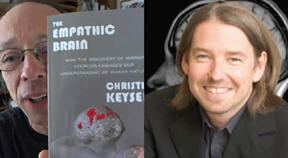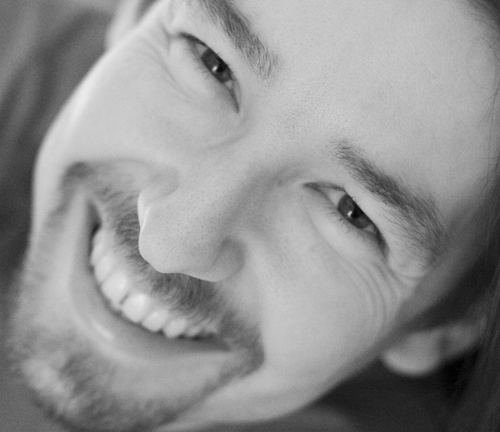Nationality German and French Occupation Scientist | Name Christian Keysers Books The Empathic Brain | |
 | ||
Full Name Christian Keysers Born June 27, 1973 (age 52) ( 1973-06-27 ) | ||
Empathic brain chapter 4 born to socialize by christian keysers
Christian Keysers is a French and German neuroscientist.
Contents
- Empathic brain chapter 4 born to socialize by christian keysers
- Christian keysers the empathic brain chapter by chapter book review
- Education and career
- Current Research Focus
- Early years
- Studies
- Research career
- Awards and Grants
- References

Christian keysers the empathic brain chapter by chapter book review
Education and career

He finished his school education at the European School, Munich and studied psychology and biology at the University of Konstanz, the Ruhr University Bochum, University of Massachusetts Boston, the Shepens eye research Institute of the Harvard Medical School as well as with Marvin Minsky at Massachusetts Institute of Technology. He then started his research career at the University of St Andrews by investigating cells in the Temporal cortex with David Perrett, and described cells that respond when the monkey views particular faces in a way that correlates with conscious perception. After that, he moved to the University of Parma where he was part of the team that discovered auditory mirror neurons in the frontal cortex of the macaque monkey. He then expanded the notion of mirror neurons to emotions and sensations, by showing that your somatosensory cortex is active not only when you are being touched, but also if you see someone else being touched, and that your insular cortex is active not only if you feel disgusted, but also if you see someone else being disgusted. More recently, he has looked at the neural basis of abnormal empathy in schizophrenia, autism and psychopathy. Currently, Keysers is a full Professor for the Social Brain at the Brain and Cognition program of the University of Amsterdam and he co-leads the Social Brain Lab of the prestigious Netherlands Institute for Neuroscience of the Royal Netherlands Academy of Arts and Sciences.
He has recently published a book called 'The Empathic Brain' which won the Independent Publisher Book Award for best science book 2012 and explains his research to a wider public.
He is married to Neuroscientist Valeria Gazzola, and is a long-standing friend of the German writer Bas Kast.
Current Research Focus

While we watch a movie, we share the experiences of the actors we observe: our heart for instance starts beating faster while we see an actor slip from the roof of a tall building. Why? Specific brain areas are involved when we perform certain actions or have certain emotions or sensations. Interestingly, some of these areas are also recruited when we simply observe someone else performing similar actions, having similar sensations or having similar emotions. These areas called 'shared circuits' transform what we see into what we would have done or felt in the same situation. With such brain areas, understanding other people is not an effort of explicit thought but becomes an intuitive sharing of their emotions, sensations and actions. Through the investigation of shared circuits, he attempts to understand the neural basis of empathy and its dysfunctions in autism, schizophrenia and psychopathy.
Early years

Christian Keysers was born in Belgium in 1973 to a German mother (Regina Rohde) and a French and German father (Gerard Edmond Keysers). He was schooled in French in Liege and later in Waterloo, near Brussels. In 1987 he moved to Munich, and went to the European School, Munich where he met Bas Kast, who's friendship came to accompany him for the rest of his life. He finished his European Baccalaureate as best of the year in 1991.
Studies
Christian Keysers then followed his growing passion for brain sciences by studying psychology and biology at the University of Konstanz, and finished his Bachelors in Psychology in 1993. He then went to Boston for one year to explore whether neuroscience research was indeed made for him. He spent several months as an intern in the insect neurophysiology laboratory of Ruth Bennett of the University of Massachusetts Boston, where he learnt many of the basics of electrophysiology. Keen to understand the neural basis of perception, he then went on to become an intern with Max Snodderly at the Schepens Eye Research Institute where he performed single cell recordings in non-human primates. In parallel, he took classes with cognitive scientist and artificial intelligence pioneer Marvin Minsky at the Massachusetts Institute of Technology. At the end of that year, he was confident that a research career in cognitive neuroscience was exactly what he wanted. He returned to Germany to finish his master program at the University of Konstanz and then performed his Master Thesis with the Tuerkish-German neuroscientists Onur Güntürkün on the origins of Brain asymmetry. Throughout his university studies, he was recognised as an unusually gifted student, and received the prestigious scholarship of the German National Academic Foundation that is awarded to the top 0.5% of students. He concluded his Masters in Psychology and Biology in 1997 with the highest possible grade. Throughout his university studies, he continued his close friendship with Bas Kast, and the passionate discussions on all topics related to brain science he had with Bas Kast greatly influenced the career of both of them.
Research career
After finishing his Master, Christian Keysers decided to concentrate on a subfield of cognitive neuroscience called social neuroscience that uses neuroscience methods to understand how we process the social world. He therefore performed his doctoral studies at the University of St Andrews with David Ian Perrett, one of the founding father of the field, to understand how the brain processes faces and facial expressions. This thesis work lead to new insights into how quickly the brain can process the faces of others. During this period, Christian became fascinated with the question of how the brain can attach meaning to the faces of others. How is it for instance, that we understand that a certain grimace would signal that another person is happy? How do we understand that a certain bodily movement towards a glass indicates that the other person aims to grasp a glass? In 1999, Christian was exposed to a visit of Vittorio Gallese, who presented his recent discovery of mirror neurons in the Psychology department lecture series. This deeply influenced Christian who decided to move to the lab of Giacomo Rizzolatti to undertake further studies on how these fascinating neurons could contribute to social perception. In 2000, after finishing his doctorate, Christian Keysers moved to the University of Parma to study mirror neurons. In early work there demonstrated that mirror neurons in the premotor cortex not only respond to the sight of actions, but also when actions can only be deduced or heard, leading to a publication in the journal science. This work had tremendous impact on the field, as it suggested that the premotor cortex could play a central, modality independent role in perception and may lay the origin for the evolution of speech in humans. Together this work indicated that brain regions involved in our own actions play a role in how we process the actions of others. Christian wondered whether a similar principle may underlie how we process the tactile sensations and emotions of others, and became increasingly independent of the research focus on the motor system in Parma. At the time, Christian had also met his to be wife, Valeria Gazzola, a biologist in the final phases of her studies, and together they decided to explore if the somatosensory system might be involved in perceiving the sensations of others. Via a fruitful collaboration with the French Neuroimaging specialist Bruno Wicker, they used Functional magnetic resonance imaging, and showed for the first time, that the Secondary somatosensory cortex, previously thought only to represent a persons own experiences of touch, is also activated when seeing someone or something else be touched. They also showed that the insula, thought only to respond to the experience of first hand emotions, was also activated when we see another individual experience similar emotions. Together this indicated a much more general principle than the original mirror neuron theory, in which people process the actions, sensations and emotions of others by vicariously activating owns own actions, sensations and emotions. Jointly, this work laid the foundation of the neuroscientific investigation of empathy. Based on this influential work, that was warded the Marie Curie Excellence Award, Christian and Valeria were offered to open their own laboratory at the University of Groningen, where Christian became an assistant professor in 2004, an associate professor in 2005 and a full professor for the neural basis of empathy in 2007, when he was only 34 years old, as one of the youngest full professors of the University. Together with his wife, his work in Groningen concentrated on using human neuroimaging techniques to understand the role of motor, somatosensory and limbic structures in understanding the inner states of others and the dysfunctions of these systems in psychiatric patients. While in Groningen, the team also demonstrated that rats show empathy for the others In 2010, they were then offered to move to the Netherlands Institute for Neuroscience, the only pure research institute in the Netherlands, funded by the Royal Netherlands Academy of Arts and Sciences. Attracted by the ability to complement human neuroimaging studies with fundamental research in rodents, using all the advanced neuroscience techniques available at the Institute, they accepted, and moved the Social Brain Lab to Amsterdam. Christian also became a full professor at the University of Amsterdam and Valeria an associate professor at the same university, but their main research lab is at the Netherlands Institute for Neuroscience where their research now focuses on understanding the mechanisms of empathy using a combination of human and animal research, using some of the most advanced techniques available, including 7T neuroimaging, neuromodulation as well as electrophysiology, calcium imaging and optogenetics.
Awards and Grants
Christian Keysers has received many of the most prestigious research grants both at the European level, including the European Research Council consolidator grant and the Marie Curie Actions Excellence Grant [1] of the European Commission, and at the national level, including the VICI grant and a VIDI grant of the Netherlands Organisation for Scientific Research. He has also received a number of highly competitive prizes, including the Marie Curie Excellence Award, the Research Prize of the University Medical Center Groningen and the Independent Publisher Book Award gold medal for best science book 2012. As a student he was a member of the Studienstiftung, Germany's most prestigious foundation for the promotion of excellence in study. He is a member of the Young Academy of Europe since 2012, of which he was elected to the Board in 2014. In 2015, he became the chair of the Humanities and Social Sciences Sections of the Academy.
